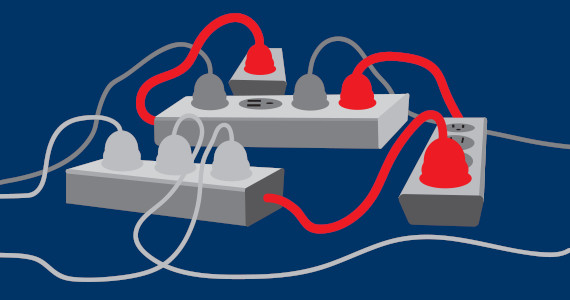It has to be highlighted that the initial extension lead is plugged into a wall socket that is rated at a maximum of 13 amps or 3kW. Now that Ive learned how to make a daisy chain to organize extension cords I hope we never fall back into this habit.
 Are Daisy Chaining Power Strips Dangerous If So Why By Liu Lisa Medium
Are Daisy Chaining Power Strips Dangerous If So Why By Liu Lisa Medium
But dont get too carried away with your daisy chain.

Daisy chain extension cords. This is even more compounded if you use use an extension cord that is not rated high enough 12AWG is good for anything you would plug into a normal wall socket. DONT exceed the rating of the cord. Without getting into the mathematics and physics of it essentially this results in greater heating of the cord and possible damage to the insulation which may be associated with a risk of fire and electrical shockcommonly known as I2R or Joule heating.
Another common solution is to create a mixed daisy chain interconnecting extension cords and power strips. This is a term that refers to power strips andor extension cords being plugged into other power strips andor extension cords. Daisy chaining is the practice of plugging multiple extension leads together or plugging many multi-socket adaptors into a single socket.
RPTs June 6 2010. 14 AWG can handle up to 15 for. But daisy chainingthat is connecting two or more extension cords or power strips together to gain additional outlets andor lengthis a very bad idea because it can overload circuits and cause fires especially if you mix extension cords and power strips.
This is a common mistake in offices that allow space heaters. Daisy-chaining extension cords is fine when the cords are of a large-enough gauge to support the extra run but can be limit the amount of power to the tool and even be a fire hazard when the gauge of extension cord is too small. Extending the length of an extension cord by daisy-chaining can lead to overheating the cord by overloading it creating a serious fire hazard.
All extension cords have wattage limits and these limits must be respected. Daisy chaining usually leads to several headaches- losing track of whats plugged in where power loss due to cord heating to potentially fire starting temperatures in some cases damage to cords due to improper placement tossing a cord across the room and letting everyone trip snag or run over them equipment damage due to cord mistreatment trip on an extension cord and rip a monitor. So if you have say 4 sets of 3 leads daisy chained or not in an installation covered by one 30mA RCD thats 12x12144mA nearly enough to trip.
Cords with proper electrical ratings should only be be used for the task at hand. Essentially the term refers to the practice of plugging a multiway extensionadapter into a mains power socket and when you run out of sockets plugging a second multiway extension into one of the power sockets on the extension. Also connecting a series of extension cords together or daisy chaining is forbidden as is using one surge protectorpower strip to power another extension cord.
Is there a potential hazard daisy chaining extension leads. What a pain to unravel. For some reason extension leads normally leak 12mA to earth when you PAT them.
This technique works on anything - extension cords ropes boat lines air hoses etc. Daisy chaining cords plugging cords together increases this distance and thus increases the extension cords resistance. The photo above on the left is what our cords usually look like.
You can end up with a high impedance cord that is not capable of delivering sufficient voltage to your end load. Electrical Extension Cords Relocatable Power Taps. Ask Question Asked 9 years 9 months ago.
Surely if the first extension lead in the chain is correctly fused there is no real hazard. I was planning to take a video of Wyatt wrapping a cord into a daisy chain but why reinvent the wheel. Keep your extension cords easy to use - a daisy chain is both easy to assemble for quick and neat storage and its easy to undo so that you can use the extension cord at the drop of a hat and not worry about frustrating knots.
Does tying a knot in a power cord provide any protection against. As a result extension leads should not be overloaded with high current appliances. Portable heaters kettles microwaves etc.
If either device is not use correctly a. That can cause things such as insufficient voltage and current to start a motor for instance which could burn up your motor and overload all of your extension cords very quickly. Daisy-chaining extension cords is a process for connecting two extension cords together when one extension cord isnt long enough.
One extension lead into another so called daisy chaining. Daisy chaining usually occurs when there are not enough established outlets to meet electrical needs. However unlike the charming childhood memories this term might provoke daisy chaining poses a very acute danger.
These guys nailed it. Safety Codes and Regulations. In electrical and electronic engineering a daisy chain is a wiring scheme in which multiple devices are wired together in sequence or in a ring similar to a garland of daisy flowersOther than a full single loop systems which contain internal loops cannot be called daisy chains.
In the world of electronics unfortunately daisy chaining isnt nearly as innocent as its name might suggest. Needs extension cords or surge protected power strips are often interconnected or daisy chained to readily provide more outlets andor to reach greater distances.